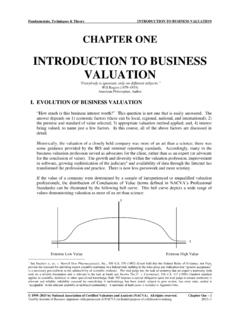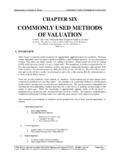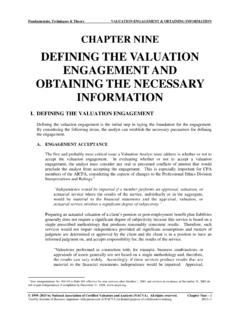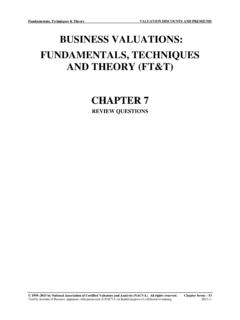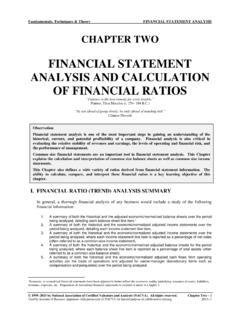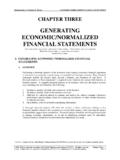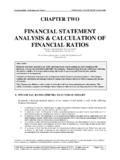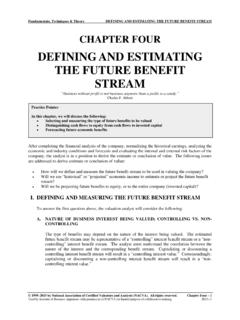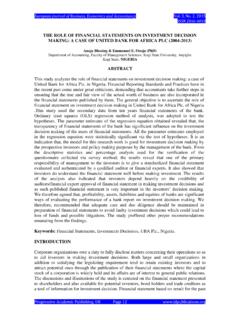Transcription of VALUATION DISCOUNTS AND PREMIUMS - NACVA
1 Fundamentals, Techniques & Theory VALUATION DISCOUNTS AND PREMIUMS . CHAPTER SEVEN. VALUATION DISCOUNTS AND. PREMIUMS . Democracy is the recurrent suspicion that more than half of the people are right more than half of the time.. E. B. White (1899 1985). Columnist, New Yorker, July 3, 1944. Author: Stuart Little; Charlotte's Web I. OVERVIEW. Determination of the value of an equity interest requires the VALUATION practitioner to carefully scrutinize the specific investment characteristics inherent in the specific equity instrument. Knowledge of these investment characteristics is critical for a proper risk assessment and, thereby, producing a conclusion of value that addresses these risks. In addition to understanding the investment characteristics of a specific equity instrument, it is equally important that the VALUATION practitioner understand the mechanics of the many commonly used VALUATION methodologies under the three broad VALUATION approaches (income, market and asset- based).
2 Depending upon valuator inputs into the mathematical models under the various methodologies, each has the ability to produce a VALUATION conclusion that differs in relation to the specific equity interest. The difference arises from the varying investment characteristics contained within the methodologies. If these investment characteristics do not parallel those of the equity interest under VALUATION , it may be necessary to modify the conclusion of value reached there under. Most often, these modifications are reflected as DISCOUNTS and/or PREMIUMS to the conclusions generated under various VALUATION methods. The two investment characteristics most often addressed in this manner are those related to control, or lack thereof, and those related to a lack of liquidity or marketability.
3 It is important to note that, by themselves, DISCOUNTS and PREMIUMS do not exist. That is to say, these items are not traded on an open market, nor is there discernable direct evidence as to the proper level of discount or premium to use in any specific instance. In effect, DISCOUNTS and PREMIUMS are the fallout of using less-than-perfect market data to measure The common acceptance of these methodologies necessitates that the business valuator utilize DISCOUNTS and PREMIUMS to modify the conclusions reached in order to accommodate the characteristics of the equity interest under VALUATION . There is often no greater dollar adjustment than that attributable to the business valuator's final determination of DISCOUNTS and PREMIUMS .
4 As a simple example, a pre- discount value conclusion of 1. Michael Bolotsky, p. xxi, foreword Business VALUATION DISCOUNTS and PREMIUMS , Shannon Pratt, 2001. 1995 2012 by National Association of Certified Valuators and Analysts ( NACVA ). All rights reserved. Chapter Seven 1. Used by Institute of Business Appraisers with permission of NACVA for limited purpose of collaborative training. VALUATION DISCOUNTS AND PREMIUMS Fundamentals, Techniques & Theory $1,000,000 would be reduced by $350,000, should the business valuator select a total discount of 35. percent. Such significant numbers are not uncommon, resulting in an ever-growing attempt by the Internal Revenue Service, as well as various state inheritance tax authorities to challenge the validity of the valuator's conclusions.
5 The Internal Revenue Service primary guidance is based on a foundation of language contained in Revenue Ruling 59-60. Revenue Ruling 59-60, 1959-1 Cumulative Bulletin 237, defines fair market value as: The price at which the subject equity ownership interest would change hands between a willing buyer and a willing seller when the former is under no compulsion to buy and the latter is under no compulsion to sell and both parties having reasonable knowledge of relevant facts.. Court decisions frequently state that, in addition to a hypothetical buyer and seller being willing, . they must also be able to trade and be well informed about the property and the market for such property. Practice Pointers Revenue Ruling 59- 60 sets forth the premise that VALUATION of closely held business interests is not an exact science and reasons that sound valuations result from: Consideration of all relevant facts Use of common sense Exercise of informed professional judgment Application of reasoned assessment A.
6 OTHER DISCOUNTS . Other value modifications beyond those considering control and marketability often include: 1. Market absorption and blockage DISCOUNTS 2. Key person/thin management DISCOUNTS 3. Investment company discount 4. Information access and reliability discount 5. Lack of diversification discount 6. Non-homogenous assets discount 7. Restrictive agreement discount 8. Small company risk discount 9. Specific company risk discount 10. Built-in gains tax discount 11. Liquidation costs discount It is important to note that VALUATION professionals often compensate for value detriment attributable to many of these items in the development of their discount /capitalization rates. As such, it is incumbent upon the business valuator to avoid a double effect of these characteristics in his or her VALUATION conclusion.
7 The key for successfully utilizing DISCOUNTS and/or PREMIUMS is to truly understand the ownership characteristics and attributes of the subject equity interest and the third party supporting base data. 2 Chapter Seven 1995 2011 by National Association of Certified Valuators and Analysts ( NACVA ). All rights reserved. Used by Institute of Business Appraisers with permission of NACVA for limited purpose of collaborative training. Fundamentals, Techniques & Theory VALUATION DISCOUNTS AND PREMIUMS . B. DISCOUNTS AND PREMIUMS / FUNDAMENTAL CONCEPTS. The fair market value of a business interest is determined by transactions between buyers and sellers. Ultimate estimation of fair market value under commonly accepted VALUATION approaches and methodologies requires the business valuator to identify and consider those ownership interest characteristics that are specific to the interest being valued.
8 Investors are risk averse. Ownership interest attributes that increase the risk of holding the investment will inherently depress the value of the ownership interest. Likewise, those specific characteristics that serve to diminish investment risk will increase that ownership interest's value. The propriety of any discount or premium is undeterminable until the base to which the adjustments are applied is clearly defined. Utilization of DISCOUNTS and PREMIUMS cannot produce a correct result if applied to an inappropriate base conclusion of value. No prescribed levels or ranges of DISCOUNTS or PREMIUMS exist from which the valuator can ascertain the proper adjustments for a specific case. Moreover, the valuator cannot expect to use a common set of computations or formulas to determine the appropriate adjustments in jobs with differing facts and circumstances.
9 Though not totally mutually exclusive concepts, the discount for a lack of ownership control (minority) and the discount for lack of marketability are generally held to be separate and distinct. While it is true that some crossover exists whereby a non-controlling interest is less marketable than a controlling interest by virtue of the non-control feature, sufficient third party information exists to support separation of the two. Otherwise, insurmountable difficulties arise in determining a proper level of combined discount . Practice pointer In those instances where the business valuator deems it appropriate to apply both a discount for lack of ownership control and a discount for the lack of marketability, the application of the DISCOUNTS is multiplicative, not additive.
10 The discount for lack of ownership control is generally applied first, principally due to the common understanding that both control and minority ownership interests may be subject to a discount for a lack of marketability. Moreover, the only empirical data for lack of marketability is available at the minority interest level, further supporting the concept of applying the minority discount first. Due to specific characteristics requiring the application of DISCOUNTS for both a lack of control and a lack of marketability, minority ownership interests in privately held businesses may be worth much less than their proportionate share of the overall business value. In other words, the sum of the parts may not add up to the whole.
